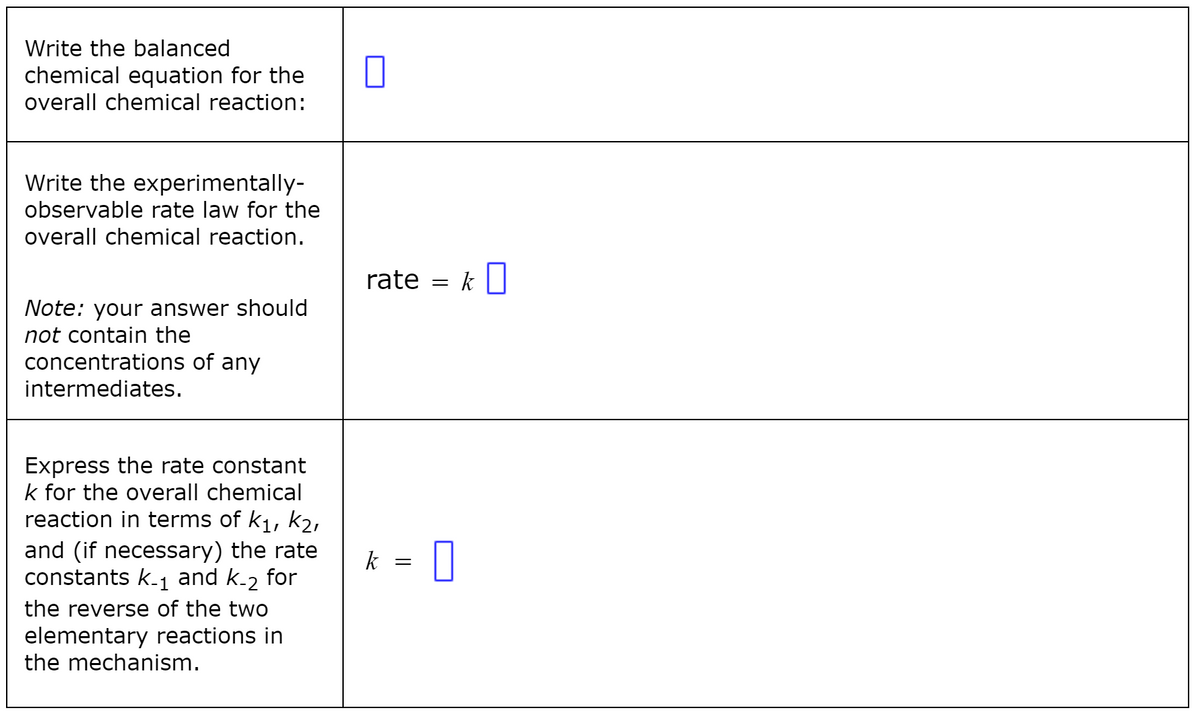Suppose the decomposition of nitryl chloride proceeds by the following mechanism: step elementary reaction rate constant 1 NO2Cl(g) → NO2(g) +Cl(g) k1 2 Cl(g) + NO2Cl(g) → NO2(g) +Cl2(g) k2 Suppose also k1≫k2. That is, the first step is much faster than the second
Suppose the decomposition of nitryl chloride proceeds by the following mechanism: step elementary reaction rate constant 1 NO2Cl(g) → NO2(g) +Cl(g) k1 2 Cl(g) + NO2Cl(g) → NO2(g) +Cl2(g) k2 Suppose also k1≫k2. That is, the first step is much faster than the second
Principles of Modern Chemistry
8th Edition
ISBN:9781305079113
Author:David W. Oxtoby, H. Pat Gillis, Laurie J. Butler
Publisher:David W. Oxtoby, H. Pat Gillis, Laurie J. Butler
Chapter18: Chemical Kinetics
Section: Chapter Questions
Problem 7P
Related questions
Question
Suppose the decomposition of nitryl chloride proceeds by the following mechanism:
| step | elementary reaction | rate constant |
|---|---|---|
|
1
|
NO2Cl(g) → NO2(g) +Cl(g)
|
k1
|
|
2
|
Cl(g) + NO2Cl(g) →
|
k2
|
Suppose also k1≫k2. That is, the first step is much faster than the second.

Transcribed Image Text:Write the balanced
chemical equation for the
overall chemical reaction:
Write the experimentally-
observable rate law for the
overall chemical reaction.
rate = k||
Note: your answer should
not contain the
concentrations of any
intermediates.
Express the rate constant
k for the overall chemical
reaction in terms of k1, k2,
and (if necessary) the rate
constants k.1
k
and k-2 for
the reverse of the two
elementary reactions in
the mechanism.

Transcribed Image Text:Suppose the decomposition of nitryl chloride proceeds by the following mechanism:
step
elementary reaction
rate constant
1
NO,C(g)
→ NO,(9) + Cl(g)
k1
2
Cl(g) + NO,Cl(g) → NO,(9) + Cl,(9)
k2
Suppose also k,»k,. That is, the first step is much faster than the second.
Expert Solution
This question has been solved!
Explore an expertly crafted, step-by-step solution for a thorough understanding of key concepts.
This is a popular solution!
Trending now
This is a popular solution!
Step by step
Solved in 2 steps with 1 images

Knowledge Booster
Learn more about
Need a deep-dive on the concept behind this application? Look no further. Learn more about this topic, chemistry and related others by exploring similar questions and additional content below.Recommended textbooks for you

Principles of Modern Chemistry
Chemistry
ISBN:
9781305079113
Author:
David W. Oxtoby, H. Pat Gillis, Laurie J. Butler
Publisher:
Cengage Learning

Chemistry for Today: General, Organic, and Bioche…
Chemistry
ISBN:
9781305960060
Author:
Spencer L. Seager, Michael R. Slabaugh, Maren S. Hansen
Publisher:
Cengage Learning


Principles of Modern Chemistry
Chemistry
ISBN:
9781305079113
Author:
David W. Oxtoby, H. Pat Gillis, Laurie J. Butler
Publisher:
Cengage Learning

Chemistry for Today: General, Organic, and Bioche…
Chemistry
ISBN:
9781305960060
Author:
Spencer L. Seager, Michael R. Slabaugh, Maren S. Hansen
Publisher:
Cengage Learning


Chemistry: Principles and Practice
Chemistry
ISBN:
9780534420123
Author:
Daniel L. Reger, Scott R. Goode, David W. Ball, Edward Mercer
Publisher:
Cengage Learning

Chemistry: The Molecular Science
Chemistry
ISBN:
9781285199047
Author:
John W. Moore, Conrad L. Stanitski
Publisher:
Cengage Learning

Chemistry: Matter and Change
Chemistry
ISBN:
9780078746376
Author:
Dinah Zike, Laurel Dingrando, Nicholas Hainen, Cheryl Wistrom
Publisher:
Glencoe/McGraw-Hill School Pub Co